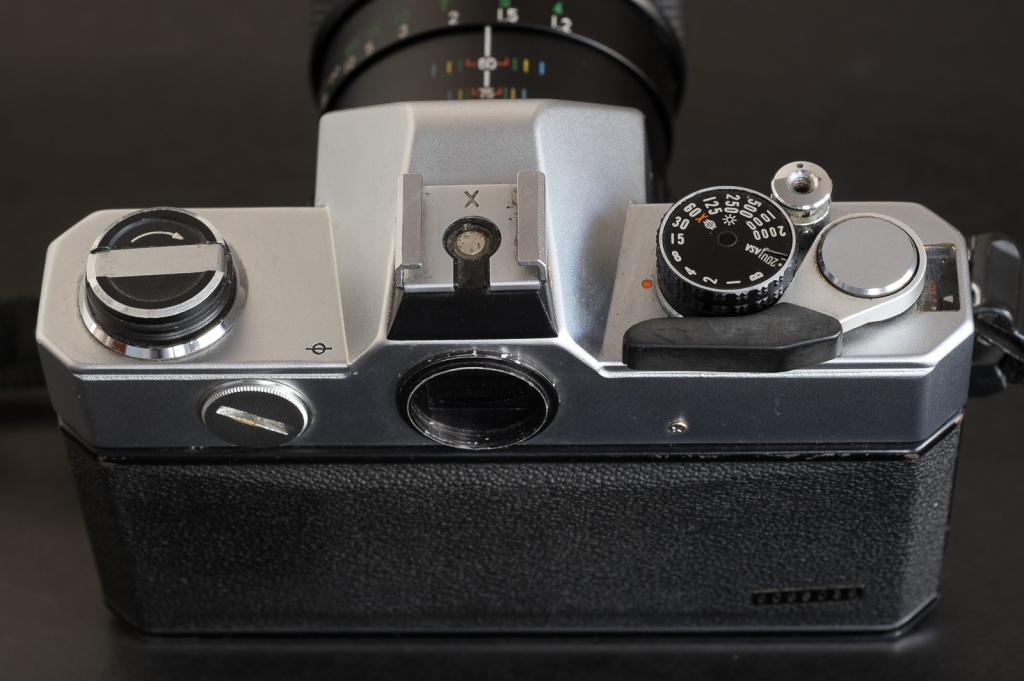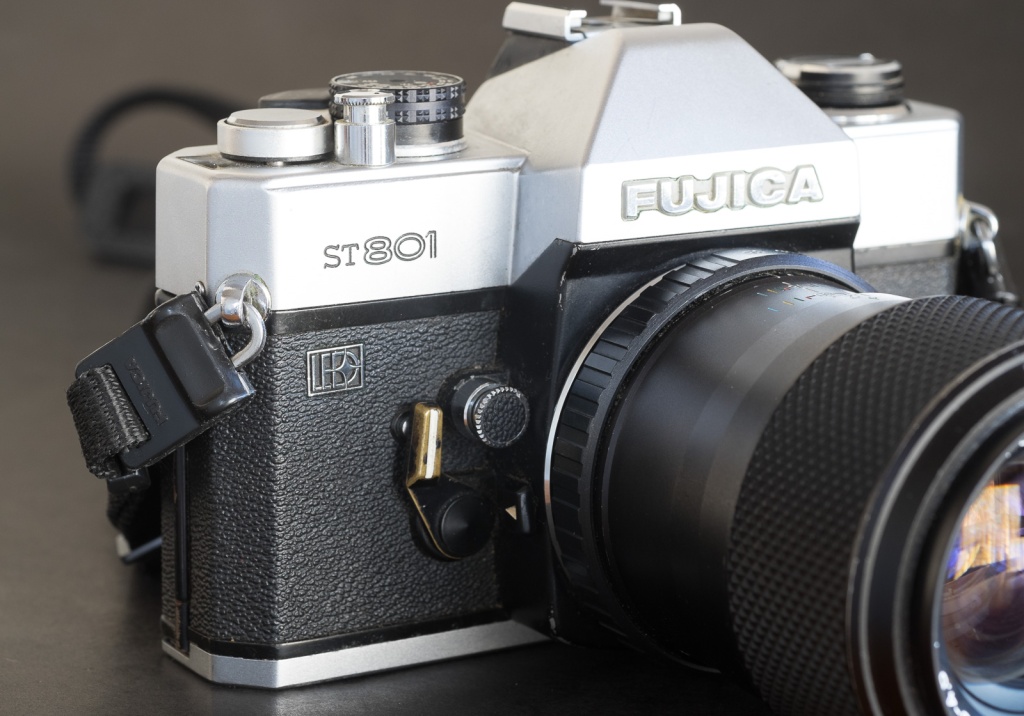
Fuji Photo was a late entrant in the single lens reflex market – they launched their first SLR, the ST701, in 1970. It was followed by a line of innovative high end models (ST 801, ST901), and by good entry level cameras (ST601, ST605, …). But those cameras were still using the old M42 “universal” screw mount that almost everybody else had abandoned.
In 1979 Fuji had to bite the bullet and finally launched a new line cameras with a new proprietary bayonet (the “X” mount), and a series of new X-Fujinon lenses (not to be confused with Fujifilm’s current XF mount, which is designed for digital cropped sensor cameras, is completely different and totally incompatible).

The “X” cameras had to face a tough competition (Canon’s AE-1 and its derivatives in particular), and were not helped by a reputation of poor reliability.
- The STX, STX-1 and STX-1n cameras were just an update of the venerable ST601 with the new bayonet mount and silver-oxide batteries. They were entry level semi-auto cameras, with a spec’d down shutter (1/2 sec to 1/700 sec). Being based on proven components and on a simple mechanical design, they were probably the most reliable of the new line of “X” cameras.
The AX-1, AX-3, AX-5 were well thought and compact cameras, but they were plagued by reliability issues (the electro-magnetic shutter release was a particular weak point, followed by the electronic components in general). The three models shared the same body, and while the AX-1 was a bit stripped down, the AX-3 and the AX-5 were full featured cameras, and looked virtually identical.
- The AX-1 is a simplified Aperture Priority automatic exposure camera, a successor of the Fujica AZ-1 and comparable to the Canon AV-1 I recently tested (there is no semi-auto exposure mode and the photographer cannot impose a specific shutter speed).
- The AX-3 is designed for the “enthusiast”: in addition to the Aperture Priority mode, it also operates in semi-auto mode, has a depth of field preview lever and supports older M42 screw mount lenses with the help of an adapter.
- The AX-5, designed to compete with the Canon A-1, it adds a shutter priority and a program mode to the feature list of the AX-3.
In the important West-German market, local constraints obliged Fuji to team with a chain of photo stores – Photo-Porst, and the cameras were relabeled and sold as the Porst CR-1 (the STX), CR-3 (AX-1), CR-5 (AX-3) and CR-7 (AX-5).

In 1983, the Fujica cameras were rebranded as “Fuji”, and the product line simplified with only the STX-2 (a limited refresh of the STX-1n with a black body and 1/1000s shutter) and the AX-Multi, an evolution of the AX-1 offering only three program modes (normal, optimized for fast moving subjects, optimized for small aperture) and no other way to control the exposure parameters.
Minolta launched the Maxxum 7000 in 1985, and made medium level manual focus cameras like the AX series immediately obsolete. Fuji finally pulled the plug on its SLR line of products in 1987.
Unless you’re an avid collector of anything Fuji, there are few reasons to look for Fuji’s X cameras:
- Fujica AX cameras may seem abundant on eBay or on the web sites of charities like Goodwill, but few of them are actually in working order.
- when new, those cameras were generally purchased by people who did not feel the need for other lenses than the standard 50mm lens that came with the camera. As a result, lenses other than the 50mm are hard to find and yes, surprisingly expensive.
- The best lenses were without a doubt the copies labeled “X-Fujinon EBC DM” – as they benefit from the EBC multicoating treatment – which had a very good reputation when it comes to reducing flare and increasing contrast, and from the “DM” version of the X lens mount (supporting all auto-exposure modes).
- But Fuji was eager to multiply the price points, and also sold non multi-coated lenses as well as one version of the 50mm standard lens (the F/1.9 FM) which did not support Shutter Priority or Program auto-exposure modes. Fuji also included in their official line-up lenses made by third parties such as Komine, under the X-Fujinar and X-Kominar labels.
- Their German distributor Photo-Porst relabeled a few of the Fujinon EBC DM lenses (sold as the “Porst UMC X-M” lenses), but not all Porst lenses were made by Fuji: Porst also relabeled lenses from miscellaneous third party manufacturers: they were sold as the Porst GMC X-M).

Fujica’s m42 screw mount lenses can be mounted on the Fujica X cameras with an adapter (they have to be used at stopped down aperture), and Fujica’s “X-Fujinon” lenses can be mounted on modern Fujifilm “X” cameras such as the XT-1 or the XT-2 via an adapter (Kiwi and Fotodiox have one, I’ve not tested them yet).
Buying a Fujica X camera today

The AX-3 appears to be the most widely distributed of the Fujica AX line, and is relatively easy to find on eBay, very often in the $30.00 to $70.00 range (for a fully tested camera). The STX and AX-1 are marginally cheaper – while the top of the line AX-5 is really hard to find, and can be proposed for prices in excess of $150.
Considering the well known issues of the AX cameras with the electronics and the electro-magnetic shutter release, it is advisable to buy only cameras that the seller has tested with a battery.
Except for the 50mm f/1.9 FM standard lens which is fairly common, X-Fujinon lenses, in particular the multi-coated EBC models, tend to be rare and very expensive ($200 to $600). Lenses from third party manufacturers such as CPC, TOU, D-Star, Hanimex and Porst’s GMC lenses are far cheaper (in the $25 to $50 price range) and easier to find. An interesting option is to use Tamron Adaptall 2 lenses – the Adaptall mount for Fujica X film cameras is still available (sometimes it’s New Old Stock), and Tamron lenses are generally easy to find at prices much more reasonable than original Fujinon lenses.
More about the AX-3 and the AX-5 in a few weeks…
Fuji Photo Film, Fujica, Fujifim, Fujitsu…a bit of history
- Fuji started its life in 1934 as “Fuji Photo Film”
- Interestingly, it renamed itself “Fujifilm” recently – although photographic film only represents 3% of Fujifilm’s business today.
- It’s a diversified group involved in document management, imaging and cosmetics.
- Fujica: Fuji Cameras were sold as “Fujica” until the mid eighties. After 1985 their film cameras were sold under the name “Fuji”, and now their digital cameras are branded “Fujifilm” – go figure.
- Fujitsu is a totally different company and has nothing to do with Fuji or Fujifilm (and so is the company manufacturing Fuji bicycles)


 Fujica AZ-1 and Fujinon-X f/3.5-4.5 43mm-75mm zoom – the AZ-1 was the first mass market SLR bundled with a zoom instead of the standard 50mm lens.
Fujica AZ-1 and Fujinon-X f/3.5-4.5 43mm-75mm zoom – the AZ-1 was the first mass market SLR bundled with a zoom instead of the standard 50mm lens.


